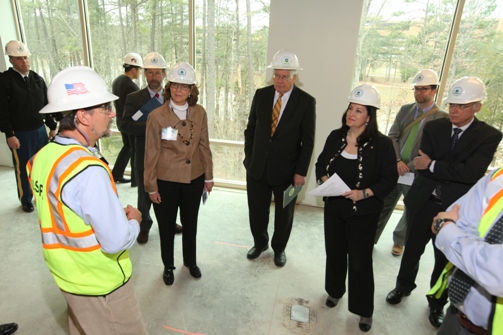This Week in EPA Science
Need a break from Shark Week? Check out the latest in EPA science.
Goats Help EPA Protect Pollinators
EPA’s research facility in Narragansett, Rhode Island recently enlisted the help of a highly skilled landscaping team to create more pollinator-friendly habitat on the premises: a herd of goats! Learn more about ‘goatscaping’ in the blog It’s a Lawn Mower! It’s a Weed Whacker! No…it’s a Herd of Goats!
EPA Researchers at Work
Meet EPA Researcher Richard Judson! Dr. Judson develops computer models and databases to help predict toxicological effects of environmental chemicals at EPA’s National Center for Computational Toxicology. Read more about his research in this Researchers at Work profile. And meet more of our scientists on our Researchers at Work page.
EPA’s Net Zero Program
Researchers with EPA’s Net Zero Program are working with the U.S. Army, U.S. Army Corps of Engineers, Kansas Unified School District 475, and others to test and demonstrate green infrastructure technology, such as permeable pavement, at Fort Riley in Kansas. Read more about the program in the Science Matters article Leaving the Gray Behind.
Toxic Substances Control Act
Last Wednesday, President Obama signed a bill to reform the Toxic Substances Control Act (TSCA), the first update to any environmental statute in 20 years. Read EPA Administrator Gina McCarthy’s blog, and the President’s remarks at the signing, during which he mentioned research being done on zebrafish.
White House Impact Report on Science, Technology, and Innovation
Last week the White House issued a list of 100 examples of leadership in building U.S. capacity in science, technology, and innovation. Some of EPA’s work was highlighted—our use of challenges and incentives, citizen science and crowdsourcing efforts, the Wildfire Science and Technology Task Force Final Report, and the Harmful Algal Blooms and Hypoxia Comprehensive Research Plan.
Shout Out to EPA’s Small Business Innovation Research Program
Before Ecovative became a leading biomaterials company, they were just two recent college graduates with a big idea—to use mushrooms to grow an environmentally-friendly and sustainable replacement for Styrofoam. Early in their business, they were awarded with one of EPA’s Small Business Innovation Research Program contracts. Gavin McIntyre, co-founder and Chief Scientist at Ecovative Design, recently wrote the letter thanking all their supporters along the way. Read the letter: Investing in the Growth of our Collective Future.
Green Infrastructure Research
EPA has been helping the city of Philadelphia advance innovative urban stormwater control. Researchers with EPA’s Science to Achieve Results program are working with the Philadelphia Water Department to place sensors in the city’s rain gardens, tree trenches, and other green infrastructure sites to monitor and measure soil and water changes. The Philadelphia Inquirer recently highlighted the research in the article Philadelphia Keeps Stormwater out of Sewers to Protect Rivers.
About the Author: Kacey Fitzpatrick is a writer working with the science communication team in EPA’s Office of Research and Development. She is a regular contributor to It All Starts with Science and the founding writer of “The Research Recap.”








 Each week we write about the science behind environmental protection.
Each week we write about the science behind environmental protection.  I was happy to be on hand this week when
I was happy to be on hand this week when